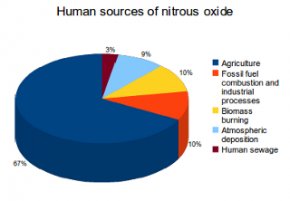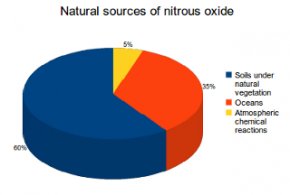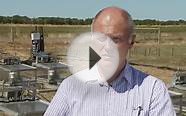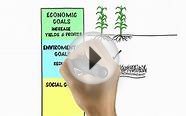Nitrous oxide emissions
 Nitrous oxide emissions are produced by both natural and human sources. Important natural sources include soils under natural vegetation and the oceans. Natural sources create 62% of total emissions. Important human sources come from agriculture, fossil fuel combustion and industrial processes. Human-related sources are responsible for 38% of total emissions.
Nitrous oxide emissions are produced by both natural and human sources. Important natural sources include soils under natural vegetation and the oceans. Natural sources create 62% of total emissions. Important human sources come from agriculture, fossil fuel combustion and industrial processes. Human-related sources are responsible for 38% of total emissions.
Human activities have added large quantities of reactive nitrogen compounds to the environment and have virtually doubled the mainly natural inputs existing at the beginning of the industrial age. However, a large portion of this is lost and cascades through the Earth's soils, water ways and atmosphere. This has increased nitrous oxide emissions by about 40-50% over pre-industrial levels.
Before the Industrial Revolution, the atmospheric concentration of nitrous oxide was maintained in a safe range of levels by natural sinks. But for a long time now human activities have been creating emissions much more rapidly than the Earth can remove them. Nitrous oxide levels are now higher today than at any other time during the last 800, 000 years.
Human Sources
Since the Industrial Revolution, human sources of nitrous oxide emissions have been growing. Activities such as agriculture, fossil fuel combustion and industrial processes are the primary cause of the increased nitrous oxide concentrations in the atmosphere. Together these sources are responsible for 77% of all human nitrous oxide emissions. Other sources include biomass burning (10%), atmospheric deposition (9%) and human sewage (3%).
 Figure 1:Source: IPCC Fourth Assessment Report: Climate Change 2007, Intergovernmental Panel on Climate Change.
Figure 1:Source: IPCC Fourth Assessment Report: Climate Change 2007, Intergovernmental Panel on Climate Change.
Agriculture
The largest human source of nitrous oxide emissions is from agriculture which accounts for 67%. Agriculture creates both direct and indirect emissions. Direct emissions come from fertilized agricultural soils and livestock manure (42%). While indirect emissions come from runoff and leaching of fertilizers (25%). Agriculture creates 4.5 million tonnes of nitrous oxide annually.
Because of the inefficiencies of nitrogen uptake by plants and animals, only about 10 to 15% of reactive nitrogen ever enters a human mouth as food. The rest is lost to the environment. Industrialized farming practices have worsened this loss and the result has been increased emissions. Because of this, agriculture is the most important human source of nitrous oxide emissions.
You might also like




|
Brady 87746 2-3/4" Width x 2-1/4" Height, B-946 High Performance Vinyl, White on Blue Medical Gas Pipe Marker, Legend "Nitrous Oxide" BISS (Brady Worldwide, Inc.)
|







